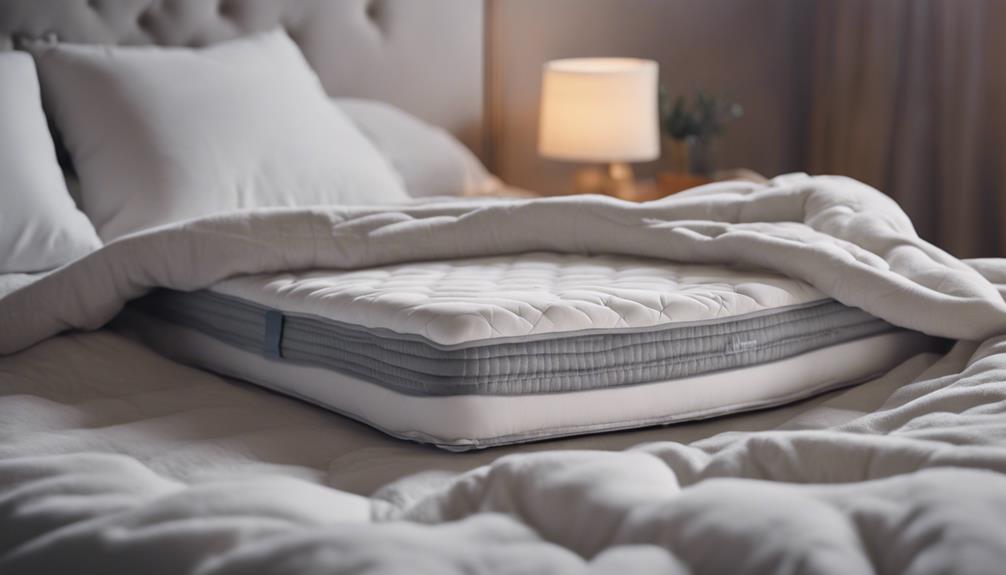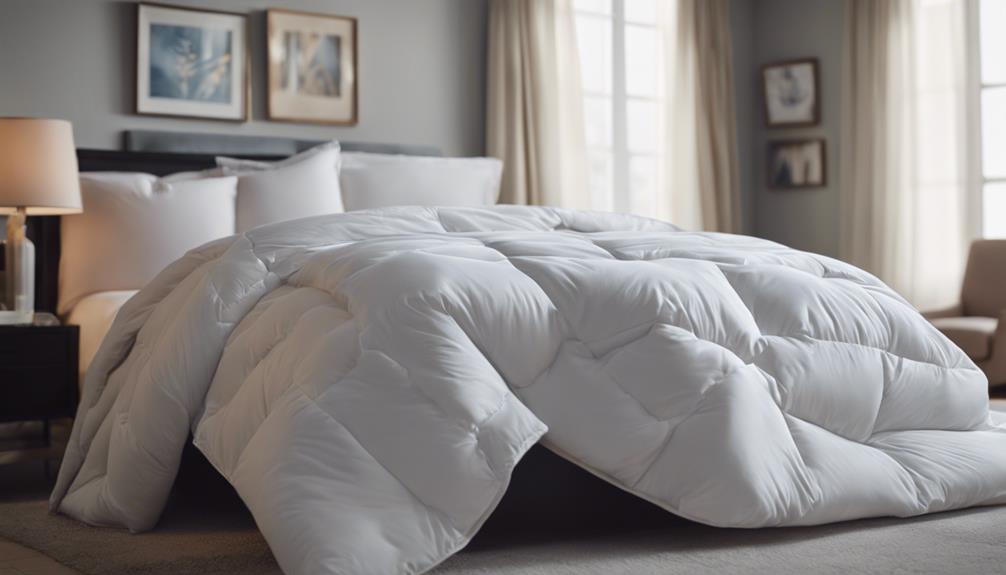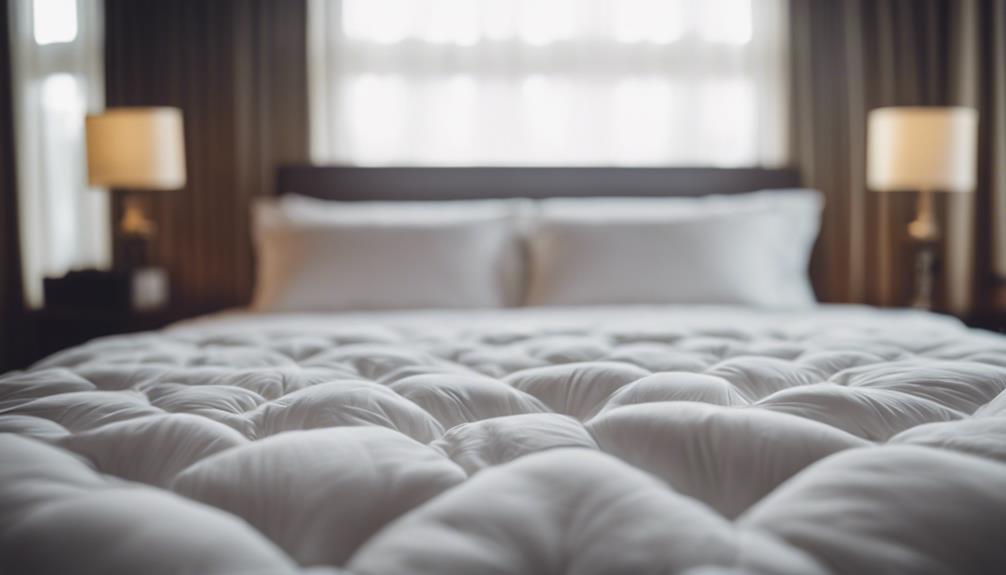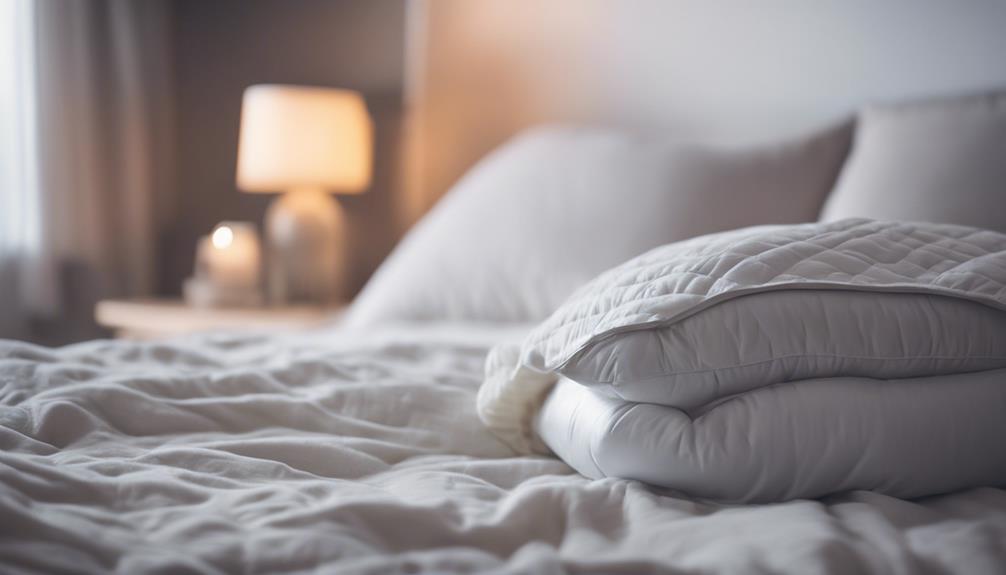Down comforters may start to smell due to moisture and natural materials, resulting in an unpleasant odor. It is important to follow proper care and maintenance techniques in order to prevent and get rid of these odors effectively. Washing the comforter in a front-loading machine with cold water and gentle detergent is recommended. Make sure to dry it thoroughly with high heat and tennis balls to maintain its fluffiness. Additionally, exposing the comforter to sunlight and ensuring proper ventilation can also help eliminate odors naturally. It is advisable to fluff the comforter daily, shake it vigorously, and consider using a duvet cover for added protection. For stubborn smells, consider washing the comforter with water and mild detergent, ensuring it is completely dried afterward.
Key Takeaways
- Improper drying can lead to a wet dog-like smell in down comforters.
- Moisture trapped in comforters causes mold and mildew growth, contributing to odors.
- Natural materials in down comforters can have a distinctive scent.
- Proper washing and drying techniques are essential to prevent odors.
- Sunlight exposure helps eliminate odors naturally by disinfecting and deodorizing the fabric.
Reasons for Down Comforter Odors

When caring for down comforters, improper drying techniques can often result in the unpleasant emission of a wet dog-like smell. This smell is commonly caused by moisture being trapped in the comforter, providing a prime environment for mold and mildew growth, which leads to odors.
Even the natural materials in down comforters can contribute to a distinctive scent, especially when they're new. To combat these odors, it's important to follow proper washing techniques and make sure thorough drying is achieved.
After washing your down comforter, make sure it's completely dry before storing or using it again. If you notice a wet smell lingering, consider airing out the comforter in a well-ventilated area to help eliminate any remaining odors.
Properly washing, drying, and airing your down comforter can go a long way in preventing and eliminating unwanted smells, keeping it fresh and cozy for years to come.
Proper Washing Techniques
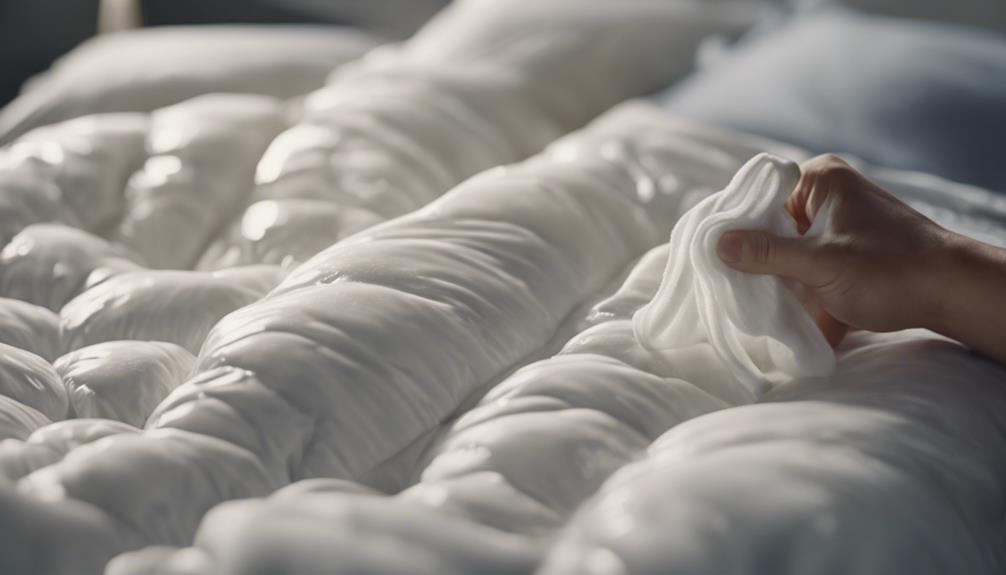
When washing down comforters, it's crucial to always use a front-loading machine to prevent damage to the delicate filling.
Opt for a gentle tumble washing cycle with cold water to safeguard the down feathers.
Thoroughly dry the comforter with one or two high heat cycles to guarantee all moisture is removed.
Gentle Washing Methods
To preserve the delicate down filling and maintain the fluffiness of a down comforter, it is recommended to wash it in a front-loading machine using a gentle tumble washing cycle. This method helps protect the down feathers and guarantees thorough cleaning without damaging the comforter. It is important to dry the comforter with one or two high heat cycles to prevent musty odors and ensure complete drying. Additionally, always keep down comforters inside a comforter cover during washing to protect them from any potential damage. For spot cleaning, consider hand washing in lukewarm water to maintain the quality of the comforter. Below is an illustrative table showcasing the key points for gentle washing methods:
| Washing Down Comforters | Gentle Tumble Washing Cycle | High Heat Cycles |
|---|---|---|
| Front-loading machine | Protects down feathers | Prevents musty odors |
Drying and Fluffing
Using low heat and adding tennis balls during the drying process can help prevent down comforters from developing odors while maintaining their fluffiness. To guarantee proper drying, set your dryer to a low heat setting and add a few clean tennis balls to the load. The tennis balls will help fluff up the comforter as it dries, preventing clumping and ensuring even drying.
If possible, consider air drying your comforter outside in the sun for a day to eliminate any lingering odors and ensure thorough drying. Additionally, adding a few extra bath towels in the dryer can aid in absorbing excess moisture and prevent any potential mildew growth.
Importance of Drying Methods
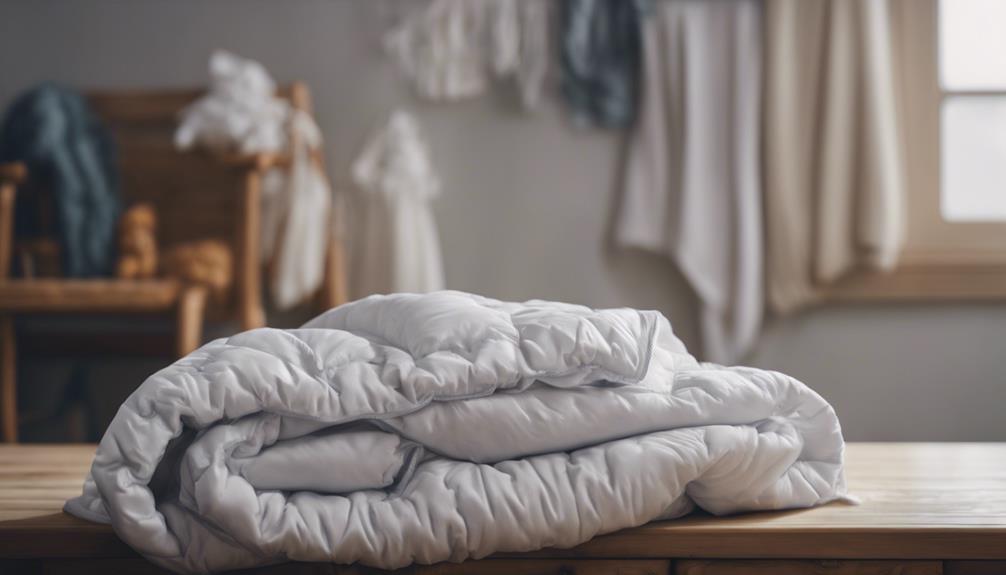
Proper drying methods play an essential role in preventing lingering odors in down comforters. After washing the comforter in a washing machine with a mild detergent and a cup of white vinegar for proper care, it's crucial to dry it thoroughly.
Using the dryer on a medium to low heat setting, along with adding tennis balls or sneakers, can help maintain the fluffiness of the comforter while also eliminating any odors. This process aids in ensuring that the comforter dries evenly without clumping.
Additionally, air drying the comforter outside can further reduce musty scents and unpleasant odors. The sun's natural UV rays can assist in killing bacteria that may cause odors, enhancing the overall freshness of the comforter.
To absorb excess moisture and prevent odor development, consider adding a few extra bath towels in the dryer. By following these drying methods, you can effectively eliminate odors and keep your down comforter fresh and cozy.
Sunlight Benefits for Odor Elimination

Sunning our down comforters outdoors utilizes the natural power of sunlight to effectively eliminate odors and maintain freshness without the need for harsh chemicals. Sunlight exposure plays an important role in odor elimination by disinfecting and deodorizing the fabric. UV rays, a component of sunlight, have the ability to kill bacteria and mold spores that are often the culprits behind bad smells in down comforters. By sunning a down comforter, musty odors can be reduced, and the bedding can be refreshed naturally.
Furthermore, the heat and light from the sun aid in drying out any residual moisture in the comforter, thereby preventing the growth of mildew. This eco-friendly method not only helps in removing odors but also contributes to maintaining the freshness of the bedding. Sunning our down comforters outdoors is a cost-effective and efficient way to eliminate odors without the use of harsh chemicals, ensuring a clean and pleasant sleeping environment.
Using Fragrance Spray Effectively

When utilizing fragrance spray to freshen up your down comforter, it's crucial to assess whether scented or unscented options are preferable for your needs.
Remember to time your spray application appropriately and guarantee even coverage to achieve the best results.
Using fragrance spray sparingly can help maintain a pleasant aroma without overpowering your living space.
Scented Vs. Unscented
Using fragrance sprays effectively can enhance the overall experience of using a down comforter. When deciding between scented and unscented options, it is crucial to take into account personal preferences and sensitivities. Scented sprays can temporarily mask undesirable odors in your comforter, creating a more pleasant sleeping environment. However, for those sensitive to strong fragrances, unscented options are available. To help you choose the right fragrance for your comforter, ponder the natural smell of the bedding and select a scent that complements it. Remember to use fragrance sprays sparingly to avoid overwhelming your senses. Below is a comparison table to help you decide between scented and unscented options:
| Aspect | Scented | Unscented |
|---|---|---|
| Odor Masking | Effective | Limited effect |
| Sensitivity | Strong fragrance | Gentle on senses |
| Personal Choice | Preference-based | Neutral option |
Timing and Coverage
To effectively utilize fragrance spray for down comforters, understanding the appropriate timing and coverage is key. When dealing with odors in your down comforter, it's important to target the source of the smell. Before applying fragrance spray, make sure that the comforter is clean and dry.
Lightly mist the comforter from a distance to achieve even coverage without saturating the fabric. Focus on areas that tend to retain odors, such as the top and sides. Allow the fragrance spray to settle for a few minutes before using the comforter.
Maintaining Freshness With Duvet Covers
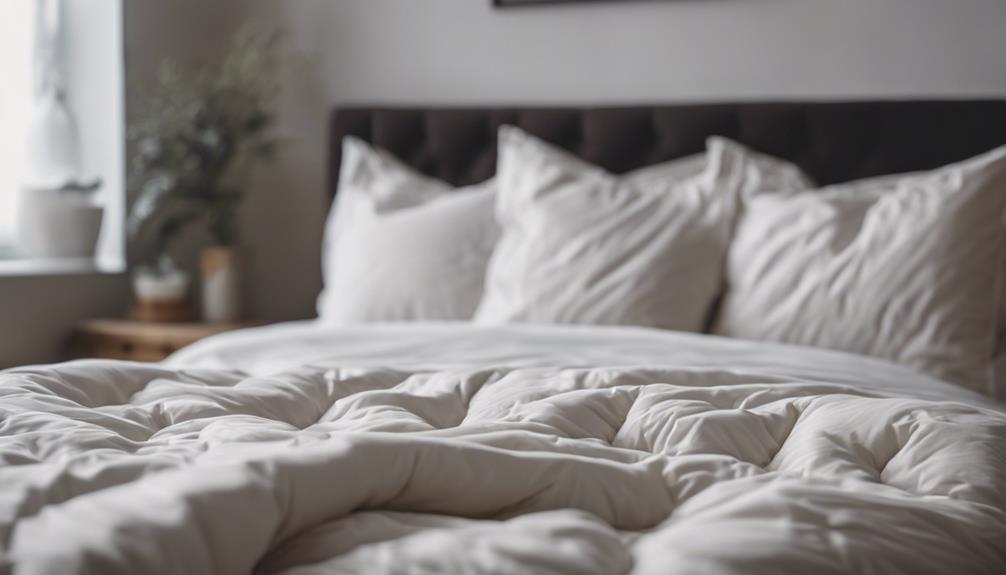
Duvet covers serve as a protective shield, safeguarding the down comforter from dirt and odors to maintain its freshness. It's vital to use fabric that's easy to wash to guarantee that your bedding stays clean.
Regularly washing your duvet covers can help in cleaning your down comforter indirectly, as they prevent dirt and odors from seeping through. If your duvet cover gets wet, make sure to dry it promptly to prevent any musty smells from developing.
Opting for duvet covers can simplify the cleaning process, as they can be washed more frequently than the down comforter itself. By using duvet covers, you not only add a decorative touch to your bedding but also extend the lifespan of your down comforter by reducing the need for frequent washes.
Choose a duvet cover that complements your style while assisting in keeping your bedding fresh and clean.
Fluffing for Daily Care
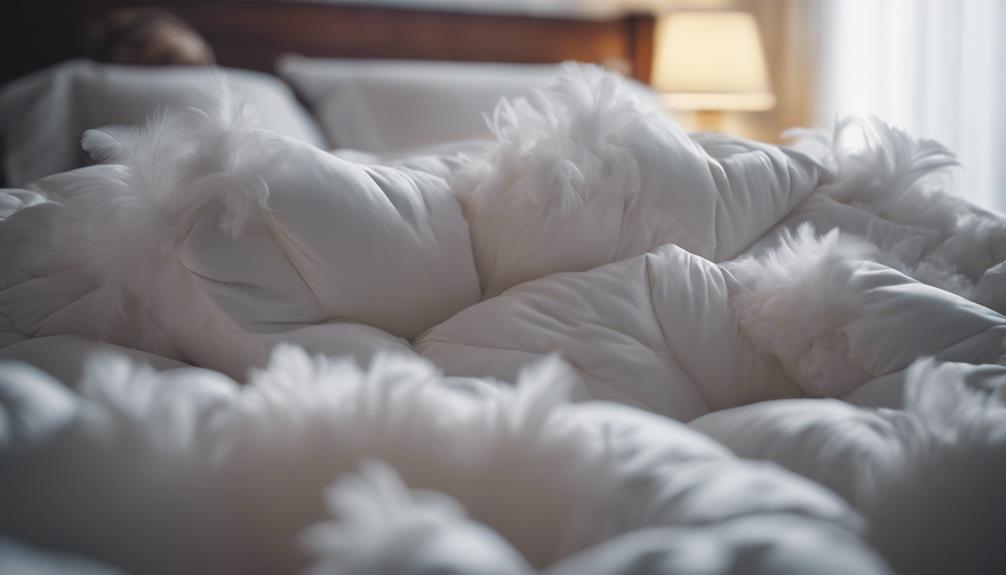
Fluffing our down comforter daily is essential for maintaining its loft and preventing clumping of the down filling. By redistributing the feathers inside, we guarantee even warmth and comfort. Here's a simple guide to help you care for your down comforter:
| Steps to Fluff Your Down Comforter | Details | Tips |
|---|---|---|
| Shake the comforter vigorously | Helps aerate the down filling | Do this outdoors if possible for better results |
| Lightly beat the comforter | Restores fluffy texture | Use a tennis racket or paddle for gentle beating |
| Consider washing if needed | Use warm water and a gentle wash cycle | Always follow manufacturer's instructions |
| Thoroughly dry the comforter | Prevents clumping and odors | Use a large capacity dryer for even drying |
| Use a duvet cover | Protects the comforter from dirt and oils | Wash the duvet cover regularly for cleanliness |
Preventing Lingering Smells

Regularly airing out down comforters can effectively reduce the chances of developing unpleasant smells. To prevent lingering odors, consider the following tips:
- Dry in the sun: After washing your down comforter, hang it outside to dry in the sunlight. Sunlight can help freshen and naturally deodorize the comforter.
- Water wash: If your comforter has a persistent smell, consider giving it a gentle wash with mild detergent and cold water. Make sure to thoroughly rinse and dry it afterward.
- Excess water: Be certain that your comforter is completely dry before storing it away. Excess moisture can lead to mold and mildew growth, causing musty odors.
- Last dry cycle: Before finishing the drying process, add a couple of clean tennis balls to the dryer. This will help fluff up the comforter and ensure it dries evenly.
- Ventilation: Allow for proper airflow in the storage area of your comforter to prevent any trapped odors. Consider using breathable storage bags or containers.
Frequently Asked Questions
Why Does My Down Comforter Smell Weird?
When your down comforter smells weird, it may be due to improper drying techniques or using the wrong detergent. To prevent this, make sure to dry your comforter thoroughly and avoid harsh detergents and fabric softeners that can leave odors.
Airing out your comforter regularly and following proper washing and drying methods can help maintain its freshness. Remember, a well-cared-for down comforter shouldn't have a strange smell.
How Do I Make My Down Comforter Not Smell?
When it comes to keeping our down comforters fresh, we rely on a few key tips.
After washing, we make sure to thoroughly dry the comforter to prevent any lingering odors. Using a mix of white vinegar and mild detergent can work wonders in eliminating smells.
Airing the comforter outside can help reduce any musty scents. And don't forget to toss in some tennis balls or sneakers in the dryer to maintain that fluffy goodness!
Does a Down Comforter Stink When Wet?
When wet, down comforters may emit an unpleasant odor resembling a wet dog smell if not dried properly. To prevent this, guarantee thorough drying after washing.
Avoid using excessive detergents or fabric softeners that can contribute to the stench. Prolonged dampness can also lead to odors, so prompt and effective drying methods are essential.
Does Goose Down Have a Smell?
Yes, goose down can have a smell if not properly cared for. While high-quality goose down shouldn't have a strong odor, improper washing methods or lack of airing can lead to unpleasant smells in down comforters.
Regularly airing out and following proper care instructions can help maintain freshness and prevent any unwanted odors from developing. It's crucial to guarantee your down comforter is well-maintained to avoid any potential smells.
Is It Normal for Down Comforters to Have a Smell, and How Can I Address It?
Yes, it is normal for goose down comforters to have a slight odor due to the natural oils in the feathers. To address goose down comforter odor issues, try airing out the comforter in direct sunlight, using a fabric spray, or adding a few dryer sheets to the dryer when fluffing the comforter.
Conclusion
To sum up, maintaining your down comforter smelling fresh is essential for a cozy night's sleep.
By following the proper washing techniques, drying methods, and using fragrance spray effectively, you can eliminate any unwanted odors.
Remember to fluff your comforter daily and use duvet covers to preserve freshness.
With these tips, your down comforter will always smell as good as new, ensuring a restful and pleasant sleeping experience.

